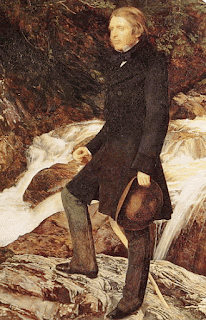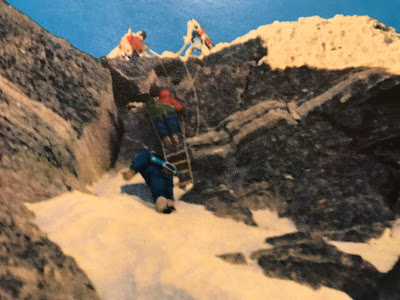When a behavioural economist asks what motivates a mountaineer
“Because it’s there.” Ask mountaineers why they climb, and this is the kind of brush-off you’ll get, mumbled often as not through a tangled growth of expeditionary beard. Much better, perhaps, to put this question to, say, an expert in analysing and even quantifying the motives that drive people’s actions.
 |
"Unrelenting misery from beginning to end ..."
An illustration from the Badminton Library: Mountaineering |
Such a specialist is George Loewenstein of Carnegie-Mellon University. Not only is he a behavioural economist, one who seeks to give the dismal science a decent grounding in human psychology, but he admits to a mountain epic or two in his younger days.In his essay "Because it is there: the challenge of mountaineering … for utility theory", Loewenstein's starting point is the concept first explored by Jeremy Bentham (1748–1832), the English philosopher and jurist who now sleeps out his eternal bivouac at University College, London.
Scholars have already hypothesised that “utility” can arise from intangibles such as memorable experiences and social kudos. Even so, it’s hard to attach any utility to mountaineering or polar exploration, which – in Professor Loewenstein’s own words – so often “tends to be one unrelenting misery from beginning to end”.
So why do people do it? One answer, the professor posits, is “self-signalling”. That is, mountaineers may be seeking esteem, at least within their own circles. At this point, the professor cites Joe Simpson, who is certainly no stranger to unrelenting misery:
The truth seemed uncomfortably egotistical. I wanted to do only hard climbs, great north faces, impressive and daunting rock routes. I wanted a ‘tick list’ of hard routes under my belt.
If there is any utility here, Loewenstein suggests, it may lie as much in convincing oneself as in dazzling others.
If self-signalling brings climbers to the mountains, the dynamic of “goal completion” may be what keeps them there. Here Loewenstein summons to the witness stand Beck Weathers, who narrowly survived a high-altitude bivouac on Everest in 1996: his earlier failure to summit the mountain
had come to possess him, take hold of his life, and control his every waking moment. And he came back this year vowing that under no circumstance was he going to allow himself to be turned around again.
Summit fever is so well documented that it should need no further explanation, at least to readers of this blog. But, as a psychological phenomenon, it does raise an interesting question. If people like to set goals for themselves, why do they stick to them when the goals no longer make sense – as, for example, when an over-large party is strung out along a summit ridge late in the day with a storm threatening.
Instead of an answer to this question, Loewenstein has a hunch:
My own suspicion is that the drive toward goal establishment and goal completion is 'hard-wired'. Humans, like most animals and even plants, arc maintained by complex arrays of homeostatic mechanisms that keep the body's systems in equilibrium. Many of the miseries of mountaineering, such as hunger, thirst, and pain, are manifestations of homeostatic mechanisms that motivate people to do what they need to do to survive, such as taking in calories (hunger) and liquids (thirst) and avoiding tissue damage (pain) … The visceral need for goal completion, then, may be simply another manifestation of the organism's tendency to deal with problems … The only difference between the visceral need for goal completion and visceral feeling of hunger is that the former goal state is, in some sense, self-chosen.
This may also explain why mountaineers often feel a sense of disappointment when they reach the long-sought summit. Quite simply, the motivation for reaching the goal is much stronger than the pleasure any summit can afford. “The discrepancy between desire and satisfaction is also characteristic of other motives such as curiosity, envy and some forms of drug addiction,” the professor adds.
Yet a third motive for mountaineering may be a sense of mastery. Again, Joe Simpson is tapped for a quotation:
there is a perverse delight in putting oneself in a potentially dangerous situation, knowing that your experience and skill make you quite safe.
Curiously, an animal experiment seems to confirm the benefit conferred by a sense of control over one’s environment. Rats who were allowed to administer alcohol to themselves had lower thresholds for brain stimulation – ie enjoyed it more – than rats who had no control over their intake. So it may be that Mo Anthoine’s account of “feeding the rat” is more than just an apposite metaphor for the climbing experience.
As a final source of utility, Loewenstein considers a paradoxical possibility – that the very misery of high-altitude mountaineering confers meaning. Maurice Herzog, the first man to climb an 8,000-metre peak lost several fingers and parts of his feet to suppurating frostbite. But this ordeal, he reported:
has given me the assurance and serenity of a man who has fulfilled himself. It has given me the rare joy of loving that which I used to despise. A new and splendid life has opened out before me.
Self-signalling, goal completion, mastery, meaning – none of these drivers are easy to define, let alone quantify. Yet they motivate at least some mountaineers far more strongly than classical economic stimuli such as the profit motive or increased consumption. Is that significant? Professor Loewenstein thinks it is:
The question, then, is whether mountaineers and mountaineering are unusual in the degree to which they are motivated by non-consumption-related motives. The answer, I believe, is that they are not. Although these non-consumption motives may be more important in mountaineering than in other activities, and better developed in mountaineers than in other people, the same motives can also be seen in most people's daily behavior.
Now that’s an interesting thought. If you could understand what drives mountaineers – if, mind – you’d be well on the way to understanding what motivates most everyone.
References
George Loewenstein, Because It Is There: The Challenge of Mountaineering ... for Utility Theory, Kyklos, vol 52, 1999.
Illustration from C T Dent, The Badminton Library: Mountaineering, third edition, 1901, ex libris Nancy Sandars.





















